|
Please be cautious about what you put out for birds. There are a lot of home-made suet recipes that are simply dangerous for birds, even deadly.
The fact is fats can get on birds' feathers and harm their ability to stay dry and warm. This lack of weatherproofing and impairment in insulation is deadly in the winter, but also the summer. The most dangerous fats for birds are the soft fats, those that are easily spread. Birds get fats on them by landing directly on a suet ball or feeder and getting the fats onto their feet. The fat is then spread as birds use their feet to preen their heads and for scratching themselves. Fats also spread by a bird having residue on their bill and then preening. The softer the fat, the more fat gets spread. The more hard, dry, and crumbly the fat, the more fat falls off and less get stuck in birds' bills and feet. Greasy birds are dead birds. Oils on feathers impair weatherproofing by interrupting the feathers' structural function. A birds' feathers are like a wet-suit; create a 'hole' in that suit and you get water or cold air access causing the bird to become cold (called 'hypothermia'). Hypothermia kills birds, and often in far less time than one can imagine. Hypothermia can be quick or slow. A bird without sufficient insulation and waterproofing, will spend hours trying to correct the feathers (preening), rather than eating. This results in starvation. A larger bird can live awhile just maintaining as a cold bird who has to eat more, preen more, and spend time shivering more (their way of creating heat). But, ultimately, a stressed life like this would not be long. Getting fats off is impossible for birds. Fats and oils on feathers are difficult to remove and cannot be done by a bird. Avian rehabilitators use a high solvent soap to remove some fats from feathers. True suet, which is what I advise to feed, is actually hard to remove (thus why a caged feeder is imperative). Rehabilitators can get fats off birds, but rarely do we get a chance since dirty birds retreat to a safe tree and perish there. The solution = use safe fats in the suets you feed and always feed suet inside a suet feeder that prevents direct access to the suet or accidental spreading (suggestions below). About Fats Melt points matter! A soft fat that easily melts has a higher tendency to spread. If a bird accidently brushes this fat, it will more easily get onto the bird. If they land on it, it will more easily get on their feet. Hard fat, like suet, is far less likely to get on the bird. Most fats, except true suet and peanut butter, have low melt points - vegetable oils, subcutaneous animal fats, bacon drippings, and many fats misnamed as 'lard' or even 'suet' melt at low temps. Making soft fats hard with ingredients (that birds don't really need like flour and corn) is not a solution; the fat used is still soft. If you can squeeze a suet and leave an imprint with your fingers - you have fat that is too soft. Note that there are cheap suets out there that are like this. All Beef and Pork FAT is not suet! The name 'suet' is getting applied to any kind of animal fat. This is particularly dangerous, and frankly not true. There are various kinds of fats from animals. True suet is the fat around the loin of a cow. It is very dry and hard, thus it crumbles when you handle it. Bacon grease, drippings from beef cooking, fats off steaks or from under the skin, or what is left-over from cooking is not suet - not even close. These fats must have dry ingredients added to them to make them hold together as a 'cake.' True suet, is the safest fat for birds. True Suet: Melt-point of 113 degrees, or higher. A hard, crumbly, dry fat. Yes, it is hard to work with if you make your own suet. However, it is better for the birds. Suet packs a serious energy punch. They do not need to eat very much to gain the fat they desperately need for their reserves and energy needs. This leaves more room for their main dietary foods (seeds or insects). Birds must get as much nutrition out of a food source as they possibly can. Poor food options require more work, less time resting, more stress, and nutritional deficiencies. This is an excellent article on true suet: https://truorganicbeef.com/blogs/beef-wiki/what-is-suet-and-tallow-difference Vegetable oils: Almost all vegetable oils have melting points of 75-77 degrees. This is way too low for a "suet" cake. These fats melt and spread easier, making them a risky option. Low melt points mean that they should not be fed at temps higher than 70. For a 'suet' cake, one must add some form of flour to hold the cake together, usually wheat, corn, sometimes oatmeal. The mix can be as high as 6 cups of flour to a mere 1 cup of fat!!! The bird must eat way more of this concoction to gain the fat benefits than they would a small suet cake (why a true suet cake will last days, and one of these possibly just hours). Please know that corn and wheat, or even oatmeal, have no where near the nutritional composition and quality of the birds' natural or even feeder seeds/foods. For insectivores, filling their bellies with high-glycemic flours instead of nutritionally sound insects results in a nutritional deficit - NOT a gain. This is true for seed-eaters as well. A sunflower seed (one of the most beneficial seeds we feed) is a nutritional powerhouse. A bird taking up precious food space in it belly to eat this low-quality suet is at a disadvantage over the long haul. Are these cakes cheap - yes. And thus the appeal. However, we must ask, are we merely inviting the birds in to entertain us, or are we attempting to offer them a true nutritional advantage? This is an ethical question we all must ask. Peanut butter - Melting point is high, 104, which is the highest. This makes PB one of the safest fats in terms of feather-risk. Suet and PB mixed are an excellent suet cake option (often called "no-melt"); the PB will make the suet easier to mix. Just make sure that the PB has NO ADDED OILS - no other vegetable oils and no sugars. The best kind is fresh ground. (Note: PB can have aflatoxins. Always use pre-made PB or if you use fresh ground, inspect for quality controls. Whole peanuts tend to have more risk of aflatoxin than does PB. Is Your "Suet" Cake Safe?: You can do a quick pinch test to determine how soft your fats (suet fats, lol) really is. Pinch the suet cake between two fingers. Does it squish? Toss it and go for a no melt beef suet that has no or little other oils in it. Note: many commercial more inexpensive suets are like this. They are not using full on suet, but likely a mix of fats. You'll also know if when you handle the suet, your hands are super greasy (hard to get off, right?). If your suet crumbles and is nearly dry - it's real suet. Feeders Cages only please. Never feed suet in a way that allows the bird to land on the fats. They will preen these fats right into their feathers.
How & When to Feed
Recipe Recipe for Favorite suet: Mix peanut butter and suet half and half, you can add some quick oat flour if you really want to, but not much. You can add seeds, nuts, and fruit. I am happy to get tips on this recipe! PM me. PS: Gelatin: Yes, this is safe for birds in limited amounts. Use this to make a seed-heavy woodpecker block. The goal is to have just enough gelatin to hold it together, not be the focus of the food (not that they would eat it anyway). This is a fun crafters project!!! Have fun feeding - do it FOR the birds. Picture is from my friend Jane Tibbetts, songbird photographer extraordinaire! She's made a safe, very neat log feeder for the suet. Thanks Jane! 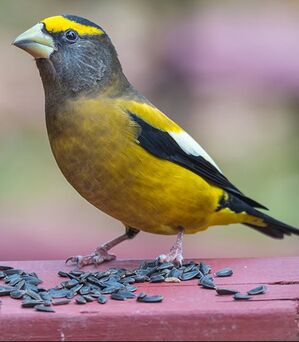 Do I eat where I poop? Do I eat where I poop? Follow these handy tips for dealing with sick or dead birds at the feeder. Sick birds are still showing up at feeders all across the country. Mainly these are Pine Siskins ill with Salmonella, a bacterial infection. Salmonella can be passed to baby birds from their parents. The species most vulnerable are the smaller finches, like pine siskin and goldfinch, but red crossbills and other birds can also get this disease. Salmonella spread is stopped through disinfecting or removing feeders, and using feeders that are less likely to spread disease. Note that contamination happens as soon as a sick bird lands on a feeder. Basics and Instructions for Cleaning, Feeder Suggestions: *1) If you have a sick bird - remove the feeders for a week or two. Take found sick birds to a rescue. *2) If you have had sick birds, switch to feeders less likely to spread disease - mesh hanging types or hoppers with very narrow feeding trough. Remove feeders that allow a bird to poop into the food! Isolate species by feeding foods specific for the species, see below. *Continue feeding ONLY if you are able/willing to keep the feeders cleaned and disinfected, and able to do this frequently. Fecal matter and saliva are how this disease is spread. Salmonella survives freezing, and hot temps, and lasts a long time in the environment. Bleach is necessary (not vinegar!). Instructions below. *If you are seeing more than one or two sick birds, please change your feeders as they are likely spreading disease. See below. Please explore the instructions below. 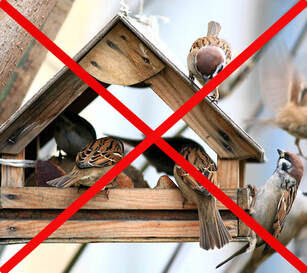 If birds can poop onto the food, then they are contaminating the food. If birds can poop onto the food, then they are contaminating the food. What to Do Now: Sick or Dead Birds:
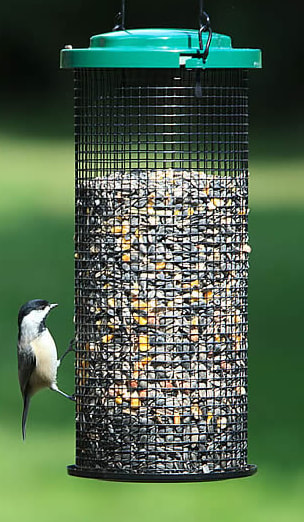 Use feeders that let birds poop on the ground. Cut off seed-catchers, use mesh feeders, hoppers with narrow feeding areas. Use feeders that let birds poop on the ground. Cut off seed-catchers, use mesh feeders, hoppers with narrow feeding areas. Feeder Tips:
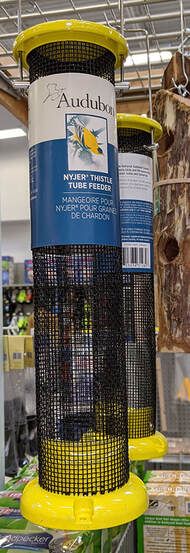 Food Choice:
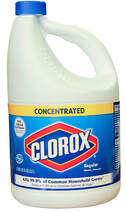 Cleaning Feeders:
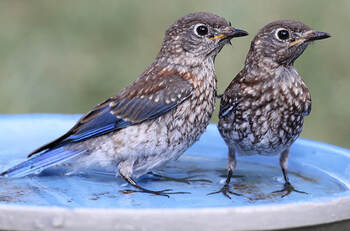 Baths & Water Features
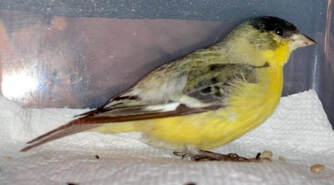 Signs of Salmonella: Symptoms: Main sign is a bird sitting listless and not moving. Salmonella causes lesions and inflammation through the digestive track and esophagus. It enters the bloodstream and then organs and brain. Once in the brain it causes mental issues, which is why sick birds act "tame" and they do not fly away. Birds ultimately die from either starvation, since salmonella lesions impair digestion, or organ failure.
What do we do if we find a sick or dead bird?
Living, but sick birds:
Can humans or pets get Salmonella? Yes, but it is not likely. The amounts in bird feces are tiny, and we are large. Cats that eat birds can and do get it. But if you have outside cats, you shouldn't be feeding birds. Chickens carry their own particular subspecies of Salmonella. It too can be spread to wild birds. In fact, agricultural animal waste is one source of Salmonella infection for wild birds, particularly those associated with those animals (starlings and house sparrows). Please use common sense when handling sick or dead birds, and when cleaning your feeders and baths. Gloves are mandatory. If you would like citations for the research mentioned, email us at [email protected] Why Pine Siskins & Finches?
Pine Siskins are particularly susceptible to Salmonella infection. The finch species experienced an "irruption" year in 2020, which is when an unusually large number of a species appears in areas further outside of their range. This trend seems to be continuing, and is likely caused by a shortage of conifer seeds. (Audubon has a nice article on this irruption). You might wonder why the Pine Siskins are ill, while the Chickadees and Nuthatches are seemingly fine. The finch family of birds seems to be more susceptible to both Salmonella and Conjunctivitis. This family includes Pine Siskin, House Finch, Evening Grosbeak, Red Crossbill, and the Goldfinches. Raptors and Owls that prey on sick birds also contract the disease. Notably, this disease was spread from agricultural poultry farms, and more birds who congregate near agricultural animals carry the infection. A few birds will carry the bacteria in their guts, without visible external symptoms. These asymptomatic carriers will shed the bacteria in their feces; if this fecal matter contaminates foods, like at a feeder, then the disease will spread. Some birds are able to overcome the disease and gain enough immunity to survive. This is usually the larger birds, like the Evening Grosbeak. Dr. Wesley Hochachka of Cornell Lab of Ornithology speculates that, "many other species are innately more able to fend off Salmonella infections," and develop immunity. However, given the death rate, he notes that it doesn't appear that this is happening for the Pine Siskin and Redpoll. How & What Diseases are Spread? Birds share disease wherever they congregate and avian scientists confirm that bird feeders are a location in which disease can be passed to other birds (Adelman et al. 2015; Dhondt et al. 2007; Galbraith et al. 2017; Hernandez et al. 2012, Lawson et al. 2018). Many diseases are spread through fecal-oral transmission (meaning the birds accidentally eat poop). Any feeder in which a bird is able to sit in their food is a potential source for infection. Flat feeders and those with large seed catchers are primary culprits. Salmonella is just one of several pathogens that can be spread at the bird buffet. Others are: conjunctivitis, avian pox, aspergillosis, trichomoniasis, and coccidia, along with internal parasites, mites, and feather lice. However, not ALL birds carry these pathogens (just like not all people carry the cold virus). In fact, studies show that only a few birds actually carry the Salmonella bacteria. Salmonella is highly contagious because it survives in the environment (say a bird feeder) for a long time- "several weeks in dry environments and several months in wet environments" (FDA). In contrast, Conjunctivitis survives from "hours to a few days" according to Dr. Hochachka. Humans can reduce disease spread by keeping their feeders clean. Our role in helping these birds is simple. We can create an environment in which the birds have a safe environment to feed. |
AboutNative Bird Care's is celebrating its 10th anniversary! Our main focus is song, shore, and waterbirds. We offer specialized care and facilities for these extraordinary birds.. Archives
July 2024
Categories
|
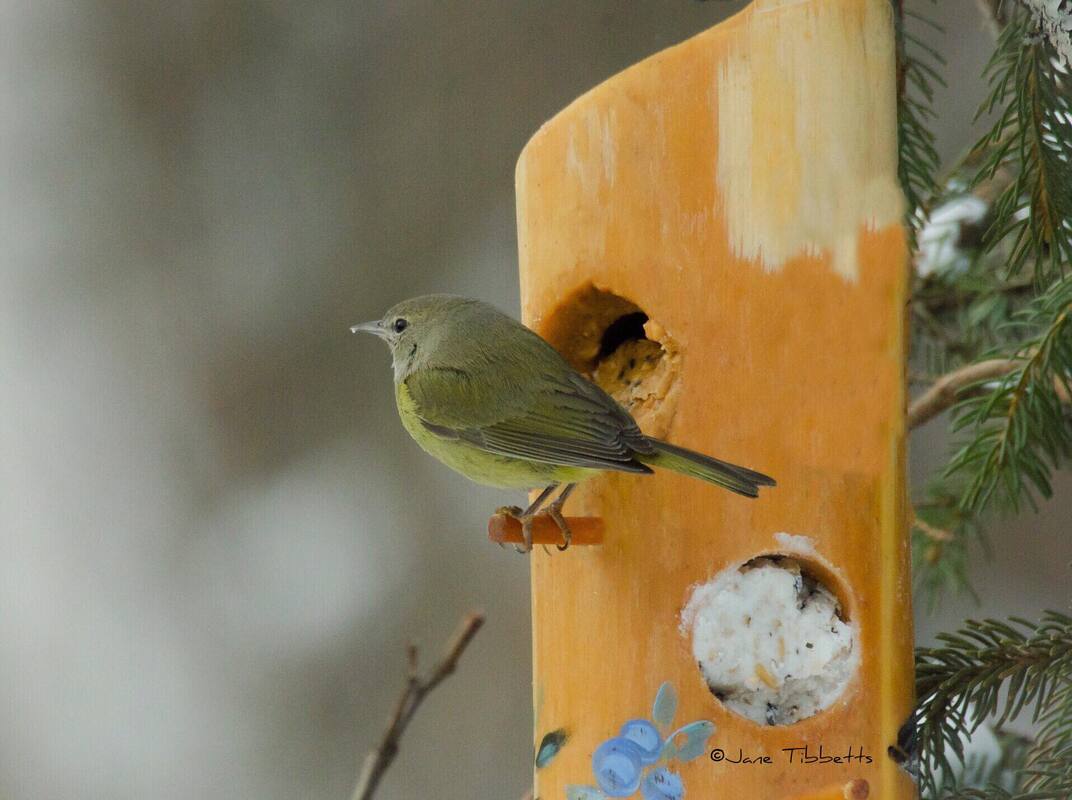
 RSS Feed
RSS Feed